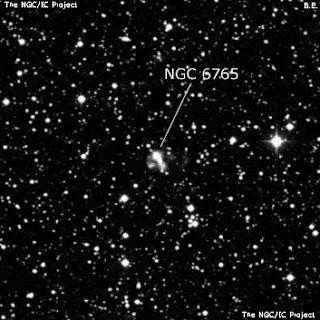It's now been one year of observing with the 12". When I first set out to find all the NGC objects I could from my location, I thought it would be a daunting and difficult task. I had no idea. I figured that pointing a 12" Dob into the overhead sky would reveal anything and everything I wished to see. It did, but what a task! I expected (and got) trouble low on the horizon (see my previous post), but did not expect that much difficulty with overhead skies. Finding some of these little faint objects from the NGC list has been really, really hard! However, the experience I have gained in the past year has been impressive. Knowing the limitations of one's scope (and eyes) is so important to observing. It has been a lot of fun finding my limitations.
The good news is that I have seen every NGC and IC object in Lyra and Cygnus, and I am nearly done with Cassiopeia! Last lunar cycle did not produce a bonanza of clear nights. There were three that worked for us. My biggest conquest (well, one of them) was locating the final unseen NGC galaxy in Lyra. I saw it 45 minutes after sunset in one of the clearest skies I have ever experienced. What makes eg 6686 so hard to see is its faintness (obviously) and its proximity to a bright star (mag 7.5, which looks like a streetlight in a 12"). I tried a number of times this summer. However, the sky on this night was as perfect as it gets, and "bingo," there it was, in all its faint fuzziness.
Other impressive accomplishments include locating (just barely) eg 45 in Cetus, and enjoying my best view ever of pn 246, not far away. The three sessions saw us observe for 11.5 hours. I snagged 21 new NGC objects and one IC, plus 9 open clusters from other catalogues. I give the facts below.
LYRA
eg 6686: Mag. 14.45. Very faint and elusive, but visible at 125x and 150x. Small and round. This completes my work in Lyra!!
CASSIOPEIA
gn 896: These two nebula appear together, separated by a small black lane. 896 is quite good with a filter, and is the brighter of the two.
gn I 1795: Appearing with 896 at low and medium powers, it is involved with a mag. 9 star. Both easy objects with the ultrablock filter on a very fine night.
eg 1343: Mag. 13.5. Located at 125x, and observed at 150x and 200x. Faint overall, but showing a brighter middle, and noticeably elongated. 2 faint stars lie immediately north.
CETUS
eg 45: Mag. 12.5. One of the biggest challenges in Cetus for northern observers is this large, very low surface brightness galaxy. After many tries, I saw it on this one superb night. 6.9 mag. and 9.9 mag stars make this even harder to see. Expect faint patchiness, in at least two locations. Located at -23 degrees. Good luck.
eg 113: Mag. 13.3. Oval and faint, a brighter center was noted at 200x.
eg 114: Mag. 12.9. Paired with 118, this was smaller but somewhat brighter.
eg 117: Mag. 13.8. Difficult object. Seen at 125x and 150x. Round.
eg 118: Mag. 12.95. Larger than 114, but seen with it at medium powers. Large and fainter.
eg 120: Mag. 13.35. Threshold object at 125x. Noticeably elongated at 150x.
eg 124: Mag. 13.1. Tricky to locate. Big and oval, best with a.v. Close to 114, 118.
eg 132: Mag. 13.2. Easy to spot at 60x! Round and ghostly at 100x. Much brighter at 200x, and quite large. Sits amidst three faint stars.
eg 145: Mag. 13.15. Oval, faint and best with a.v. at 100x, 125x.
eg 161: Mag. 13.35. Like a star out of focus at 125x. Very small. 150x shows elongation. 200x shows a stellar core.
eg 173: Mag. 14.1. Ghostly at 125x, it was acceptable at 150x and 200x. Very large with a low surface brightness, I wish to return here for a 2nd look.
eg 179: Mag. 13.05. At -18 degrees. Spotted at 100x. Oval with a bright middle or perhaps a star within. 125x and 150x shows well.
eg 209: Mag. 12.95. 1 degree S of 179! Small, round and very faint. Appears to have a stellar core.
eg 255: Mag. 12.9. Lying at -11 degrees, 28', this one has proved impossible up till my one fabulous night. Easy tonight! Round and ghostly, like a planetary nebula. Large at 125x (though considerably smaller than nearby pn 246).
eg 1070: Mag. 12.75. Seen at 60x, 100x, 125x and 150x. Round, faint but large. Oval at 150x.
eg 1085: Mag. 12.8. Small and faint. Should be brighter. Will return for a 2nd look.
eg 1137: Mag. 13. Views improve at 125x and 150x. Considerably elongated using a.v.
eg 1153: Mag. 12.35. Small and faint. Oval at 150x, with a brighter middle.
CLUSTERS FROM OTHER CATALOGUES
Cassiopeia
oc Be 4: 15 faint stars around a bright one.
oc Be 61: Small, hazy patch at 60x. Resolves at 125x upward, but very few stars.
oc Be 62: A dozen faint stars involved with a 5-star asterism. Use high power.
oc Be 104: S of star V639. 6 stars resolved at 250x, hampered by the variable.
oc Do 13: Large and widely scattered group. About 40 stars at 100x, many of them bright. Attractive group.
oc King 1: Very faint at 60x. 150x shows 16 stars in 2 groups. A bright group is adjacent.
oc Skiff j00584+6878: 125x begins to show a dozen stars, widely scattered. Out of the way.
oc St 18: Line of 5 bright stars. 2nd from west surrounded by faint stars.
oc St 21: A 'V'-shaped group was noted, open end to the NW. The line of stars in the S (running E-W) has a compact group of very faint stars around it. The whole 'V' is attractive.
Mapman








